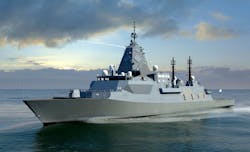Navy taps BAE Systems for circular shipboard radar antennas for frigates, cruisers, and aircraft carriers
Summary points:
- BAE Systems will deliver OE-120/UPX Antenna Group Systems to the U.S. Australian, and Japanese navies for IFF, radar, and air traffic control.
- OE-120B offers microsecond-fast targeting, electronic beam steering, and support for IFF modes to enhance situational awareness.
- The OE-120 system can track as many as 400 targets and synchronizes with several onboard radar displays.
PATUXENT RIVER NAS, Md. – U.S. Navy RF and microwave experts needed circular shipboard antennas for identification-friend-or-foe (IFF), secondary surveillance radar, and air traffic control radar applications. They found a solution from BAE Systems.
Officials of the Naval Air Systems Command at Patuxent River Naval Air Station, Md., announced a $15.9 million order earlier this month to the BAE Systems Electronic Systems segment in Nashua, N.H., for OE-120/UPX Antenna Group Systems.
The BAE Systems OE-120 antennas for shipboard radar is an electronically steerable antenna that shipboard operators can redirect within 50 microseconds to interrogate any target on the horizon. The antenna array supports IFF interrogator as well as air traffic control beacon systems, and is designed for surface ships and land-based installations.
This order consists of seven OE-120/UPX Antenna Group Systems -- three for the Navy and two each for Australia and Japan; four OE-120 retrofit kits -- two each for Australia and Japan; two installation and checkout (INCO) kits -- one each for Australia and Japan; and one delta INCO kit for the Navy.
Multi-target identification
The OE-120B antenna groups offer instantaneous multiple-target identification for use against today’s sophisticated air threats. It accommodates all standard IFF modes.
The antenna system adapts to land and sea applications to support a variety of mission environments, and its electronically steered system architecture offers increased reliability and reduced maintenance. Its array configuration allows for smooth performance degradation in the event of a failure.
The OE-120 electronically steerable antenna is suitable for the Navy's Arleigh Burke-class destroyers (DDG 51); Ticonderoga-class cruisers (CG 47); Wasp-class amphibious assault ships (LHD 1); San Antonio-class amphibious transport docks (LPD 17); aircraft carriers; the Japanese Kongo-class destroyer (FMS DD 173) -- a version of the U.S. Burke-class destroyer; and the Australian Anzac and Hunter-class frigates.
Identification friend-or-foe
The AN/UPX-29(V) shipboard IFF interrogator, for which the OE-120B antenna is part, distinguishes friendly vessels and aircraft nearby during combat operations.
The AN/UPX-29(V) can process and store as man as 400 targets, provide instantaneous interrogation on a target within 25 microseconds, electronically evaluate Mode 4 replies, call up operator-designated target information, display IFF targets synchronized with as many as four radar systems at 22 displays, and interface with shipboard computers.
At the heart of the OE-120 system is the AS-3134/UPX antenna array, which consists of 64 vertical radiating dipole antenna element pairs arranged in a circle on the ship's mast. The system uses electronic beam steering to scan all areas around the ship. The dipole antenna element pairs can produce either directional or omnidirectional beam patterns.
Any point on the horizon
The system can aim its RF energy at any target of interest located at any point on the horizon within microseconds. Operators also can scan the antenna's output rapidly over a designated sector of interest. During normal surveillance operations the antenna group scans the horizon at 90 revolutions per second.
The OE-120's CV-3372/UPX antenna positioner receives commands from the C-10063/UPX controller, distributes RF power to the radiators, and digitally controls the system's output mode and boresight direction. The system's C-10063/UPX antenna controller, meanwhile, is located below decks and translates synchronized data continuously from the ship's environmental sensors.
On this contract, BAE Systems engineers will do the work in Nashua, N.H., and should be finished by January 2028. For more information contact BAE Systems Electronic Systems online at www.baesystems.com/en-us/who-we-are/electronic-systems, or Naval Air Systems Command at www.navair.navy.mil.
About the Author
John Keller
Editor-in-Chief
John Keller is the Editor-in-Chief, Military & Aerospace Electronics Magazine--provides extensive coverage and analysis of enabling electronics and optoelectronic technologies in military, space and commercial aviation applications. John has been a member of the Military & Aerospace Electronics staff since 1989 and chief editor since 1995.
